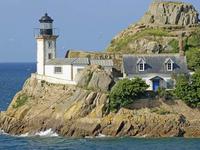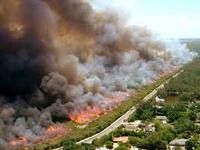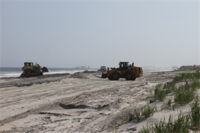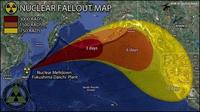-
Study links prehistoric climate shift to asteroid or comet impact
For the first time, a dramatic climate shift which has long fascinated scientists has been linked to the impact in Quebec of an asteroid or comet. The event took place about 12,900 years ago, at the beginning of the Younger Dryas period, and marks an abrupt global change to a colder, dryer climate, with far-reaching effects on both animals and humans.
-
-
Future of coal in Australia riskier than renewables
Coal-fired electricity may have little or no economic future in Australia, even if carbon capture and storage becomes commercially available, a new analysis has found. The study shows that coal with carbon capture and storage scenarios are likely to struggle to compete economically with 100 percent renewable electricity in a climate-constrained world, even if carbon capture and storage is commercialized by 2030.
-
-
Global warming increasing risk of record heat: scientists
Drought shriveled crops in the Midwest, massive wildfires raged in the West, and East Coast cities sweltered. The summer of 2012 was a season of epic proportions, especially July, the hottest month in the history of U.S. weather record keeping. As the world warms, it is likely that we will continue to see such calamitous weather. Scientists caution against trying to determine whether global warming caused any individual extreme event, but they say that the observed global warming clearly appears to have affected the likelihood of record heat.
-
-
High performance concrete to rescue Brittany's lighthouses

Lighthouses in Brittany, France, have stood at the intersection of violent currents, blinding storms, and breaking surf for over a century. A lighthouse turret off the coast of Lorient in Brittany has been enhanced with technology developed for bridges. This trial run will test the application of Ultra-High Performance Concrete (UHPC).
-
-
Limestone powder enhances performance of “green” concrete

Adding limestone powder to “green” concrete mixtures — those containing substantial amounts of fly ash, a byproduct of coal-burning power plants — can significantly improve performance. The promising laboratory results suggest a path to increasing greatly the use of fly ash in concrete, leading to sizable reductions in greenhouse gas emissions, energy use, construction costs and landfill volumes.
-
-
Knowing exposure risks crucial to saving structures from wildfires

A recent study of one of California’s most devastating wildland fires strongly suggests that measures for reducing structural damage and property loss from wildland urban interface (WUI) fires are most effective when they are based on accurate assessments of exposure risks both for individual structures and the community as a whole.
-
-
U.S. “black budget” reveals unwieldy bureaucracy, misplaced priorities: expert
Classified budget figures and successes and failures by American intelligence agencies, exposed for the first time this week by the Washington Post, show a massive bureaucracy with misplaced priorities, according to a cybersecurity and privacy expert. “The major failure identified in all of the post-9/11 assessments was a ‘failure to connect the dots,’” the expert said. “Nevertheless, the vast majority of the black budget is being spent on data acquisition — collecting more dots — rather than analysis.”
-
-
Deflecting asteroids to protect Earth
Potential asteroid impact on Earth can have disastrous consequences. In order to prevent such collisions, earthbound space objects must be deflected. This can be accomplished using a space probe to impact the asteroid.
-
-
Using desalination to secure water in the desert
Researchers are working on an innovative project to secure water supplies in desert communities which suffer from having an acute shortage of fresh water, but abundant hypersaline groundwater. Hypersaline water is even saltier than seawater.
-
-
Shale gas threatens U.S. nuclear power industry
The U.S. nuclear industry is facing a new enemy, and it is not anti-nuclear peacenicks. It is the shale gas boom, which on Tuesday claimed yet another victim when Entergy Corporation said it would close its Vermont Yankee reactor ahead of schedule. It is the fourth U.S nuclear plant to be closed this year, as utilities have concluded that investing in refurbishing older reactors is no longer economically viable.
-
-
Sandy Task Force issues sixty-nine rebuilding recommendations
The Hurricane Sandy Rebuilding Task Force, appointed by President Obama and chaired by Housing and Urban Development secretary Shaun Donovan, last week release its much-anticipated report, in which it lays out sixty-nine policy recommendations for improving areas affected by Hurricane Sandy last October. The report stressed the importance of investment in new and better construction to withstand increasingly dangerous storms and surges caused by climate change.
-
-
Jersey shore towns build protection against future storms

Mantoloking and Brick townships in New Jersey were among the hardest hit by Superstorm Sandy. The storm also destroyed the natural dune barriers which offered a measure of protection. The two cities have decided to take action to minimize the damage of inflicted by a future storm: a $40 million project will see a steel wall —extending sixteen feet above the beach with a depth of thirty-two feet below the ground, and covered in sand to form an artificial dune — will run along the length of the two towns.
-
-
Fukushima radioactive plume to reach U.S. next year

The radioactive ocean plume from the 2011 Fukushima nuclear plant disaster will reach the shores of the United States within three years from the date of the incident, but is likely to be harmless, according to a new study. While atmospheric radiation was detected on the U.S. west coast within days of the incident, the radioactive particles in the ocean plume take considerably longer to travel the same distance.
-
-
Understanding the effects of wildfire smoke improves climate change models
Where there is wildfire, there is smoke — a lot of it. Those vast, carbon-laden clouds released by burning biomass can play a significant role in climate change. Not much is known, however, about the different types of particles in wildfire smoke and how they affect climate. Now researchers have uncovered some of their secrets. In particular, they studied an important component of smoke that has so far been absent from most models of climate change.
-
-
Beach erosion by Hurricane Sandy leaves coastal communities more exposed to future storms
Barrier islands provide natural protection against storms, shielding coastlines from rising waves and tides. Beaches and dunes on Fire Island, New York, lost more than half of their pre-storm volume during Hurricane Sandy, and the loss of so much sand increases the vulnerability of this area of coastline to future storms.
-
More headlines
The long view
Water Wars: A Historic Agreement Between Mexico and US Is Ramping Up Border Tension
As climate change drives rising temperatures and changes in rainfall, Mexico and the US are in the middle of a conflict over water, putting an additional strain on their relationship. Partly due to constant droughts, Mexico has struggled to maintain its water deliveries for much of the last 25 years, deliveries to which it is obligated by a 1944 water-sharing agreement between the two countries.
Trump Is Fast-Tracking New Coal Mines — Even When They Don’t Make Economic Sense
In Appalachian Tennessee, mines shut down and couldn’t pay their debts. Now a new one is opening under the guise of an “energy emergency.”
Smaller Nuclear Reactors Spark Renewed Interest in a Once-Shunned Energy Source
In the past two years, half the states have taken action to promote nuclear power, from creating nuclear task forces to integrating nuclear into long-term energy plans.
Keeping the Lights on with Nuclear Waste: Radiochemistry Transforms Nuclear Waste into Strategic Materials
How UNLV radiochemistry is pioneering the future of energy in the Southwest by salvaging strategic materials from nuclear dumps –and making it safe.
Model Predicts Long-Term Effects of Nuclear Waste on Underground Disposal Systems
The simulations matched results from an underground lab experiment in Switzerland, suggesting modeling could be used to validate the safety of nuclear disposal sites.
